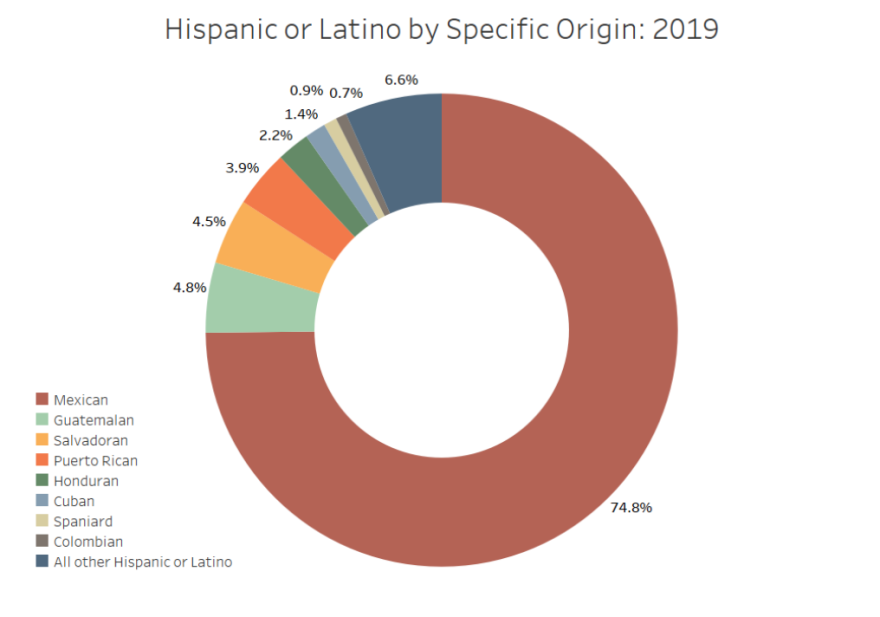The number of Latinos in Iowa continues to grow, and most of the state's Latinos still claim Mexico as their country of origin. But a recently-released profile of Latinos in Iowa shows that growing population is also getting more diverse.
Every year, a colorful collection of pdf files appear on the State Data Center of Iowa’s website describing what the state's Latino population looks like. The numbers and percentages vary, but one constant change is the rainbow pie chart at the bottom. It shows the population breakdown by country of origin.
Ten years ago, it was almost entirely blue—which meant the majority of Latino Iowans had their origins from Mexico. In 2020's report, Mexico's color has changed to a burnt orange, but that's not the only difference. The other pieces of the pie have grown while the slice representing Mexico has shrunk. That’s because the percentage has hit one of its all-time lows. While still the largest Latino group, today just 74.8 percent of Iowa Latinos are of Mexican heritage.
This is not just visible by a slice of pie—Latino leaders have also noticed.
“So I think is very important also, to have that diversity in businesses and in everything in the media, so people see that not all Latinos are from Mexico," said Sonia Reyes, the director of the Iowa Office of Latino Affairs.
She knows firsthand how diverse the state’s largest minority group is—and that the numbers are not lying.
“I think it's important for us to show all of our strength, all of our amazing things that we bring our different cultures," Reyes said.
This year’s statistics also have the most colors on that country of origin pie chart. It lists nine different nationalities. Colombians finally make up enough of the state’s Latinos percentage to have their own representation at .7 percent. It’s the smallest pie slice there, but present nonetheless. In years past, the pie chart did not differentiate between different ethnicities, but rather different regions, using signifiers such as Central American and South American. The modern charts now differentiate which country within those regions Latinos in Iowa come from.
A lot of the reason why these numbers are readily available is because of a man named Gary Krob. He works for the State Data Center of Iowa as a coordinator. He profiles minority groups in the state including African-Americans, Asian Pacific Islanders and also statistics on the status of women in the state. He tries to release the data during significant months for each group. He releases the Latinos of Iowa profile during Hispanic Heritage Month in September, the African-American profile during Black History Month in February and the status of women profile during Women's History Month in March.
“I think it's important with these profiles for people to understand that there is change going on," Krob said.
There are 198,550 Latinos in Iowa as of this year. It’s a growing number, but it’s still just about 6 percent of the state’s overall population. The pie chart shows that there are different Latinos here, from all over the country and the world.
The majority of Latinos in the state are still either from Mexico or their family is from there. But there are growing slices of the pie for Guatemalans, Salvadorans and Puerto Ricans. Each of them hit some of their own highs at 4.8, 4.5 and 3.9 percent respectively. Reyes said one reason for the growth in diversity is because Iowa is so welcoming.
“I think that it's a place where you can thrive in, which is why people continue to come," Reyes said.
That could definitely be seen as a thumbs up for Iowa, but as the state becomes more diverse, Reyes said there needs to be more resources and recognition. Otherwise, Latino Iowans could get stuck in an “identity crisis.”
“I lived with my children, they are both first generation. And they were caught in like three different worlds," Reyes said. "My world, the white world, the Iowa world, and then the one in between.”
That’s why Krob said more than just Latinos need to look at these profiles and understand the growing diversity.
“It's really, I think, important to understand that and to be able to look at these different communities and see some of the differences," Krob said. "And see maybe also where as a state, I don’t want to say falling behind, but where we need to do some work in order to help these Iowans.”
Nick Salazar, the state director for the League of Latin American Citizens, said as the diversity of Latino Iowans becomes more visible, it breaks down the negative stereotypes of the state.
“It shows the rest of the country that Iowa isn't just a bunch of white folks, Iowa is diverse. And not just with Latinos, but the diverse Latino community that we have with these different folks," Salazar said.
He said this growing diversity plays an even bigger role during an election year.
"Depending on the community you go to, we will see folks from different countries other than Mexico, but I'm glad to hear that it's actually showing up in the numbers. And we actually have more than just one race going to the polls," Salazar said.
Even though Iowa has added Colombians to the pie chart this year, there is still an entire slice that encompasses all other Iowa Latinos. 6.6 percent of the pie is labeled as “All other Hispanic or Latino.” This serves as a sort of "all other" column for ethnicities that do not have a large enough population to have a significant percentage represented.
This story was done in collaboration with Hola Iowa.




